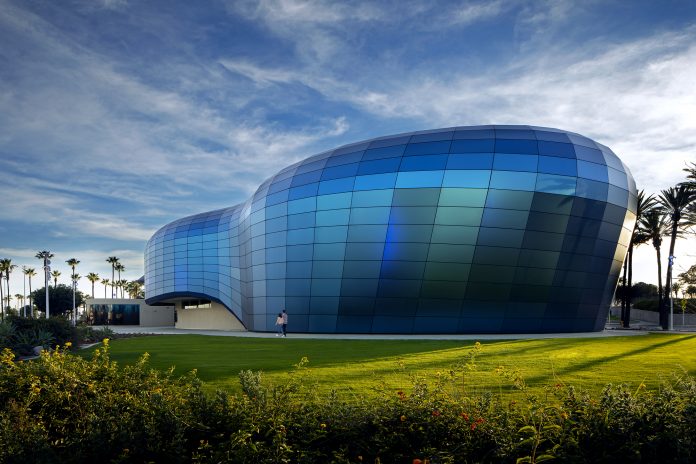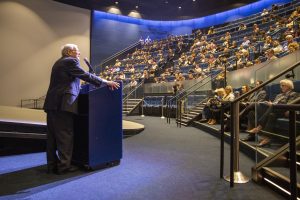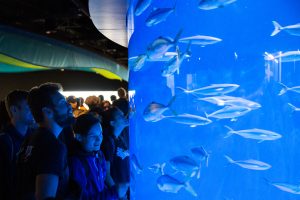
$53 million expansion opened earlier this summer and is all about conservation
By Brooklynn Wong
Long Beach’s Aquarium of the Pacific has long been highly-regarded as a hub of underwater education and spectacle.
But a $53 million addition has taken it to the next level.
The Pacific Visions expansion is an addition that takes the Aquarium of the Pacific from aquatic zoo to all-encompassing educational center.
Not since the aquarium opened in 1998 had there been a major expansion until this one.
Ground was broken in February 2017 on Pacific Visions—a big blue add-on that contains a theater, an art gallery, game tables and live animal exhibits—and it opened to the public May 24 of this year.
The 29,000 square-foot two-story structure is a collaboration between the aquarium and several highly-regarded design and technology firms.
EHDD, a San Francisco architecture and design firm, brought to life the exterior of this big, reflective whale-esque addition.

Aquarium visitors can still see all the fauna they always could, from penguins, and turtles and frogs, to harbor seals and sharks, but now they can round out their experience by learning about sustainability. This is at the center of Pacific Visions.
Some estimate that by the year 2050, there will be about 10 billion humans on the earth. The ocean plays a major role in providing oxygen, food and water to the earth’s inhabitants. The aquarium has taken on a new role of making people aware of the changing climate, and letting them know how they can make sustainable and environmentally-friendly lifestyle choices.
Said Aquarium President Dr. Jerry Schubel when asked about this, “Programs and exhibits at the Aquarium have always communicated messages about conservation and sustainability, but Pacific Visions takes on the urgent challenge we face in creating a sustainable future for a growing human population while conserving nature….We have a responsibility to serve as gathering places where people can collectively explore our relationship with our planet and alternative pathways to a sustainable future.”
When you enter the aquarium, veer right and you’ll find yourself in Pacific Visions.

First comes “Reefs & Drifters.” This is the art gallery portion of Pacific Visions. Coral and plankton are the emphasis here. They are an often-overlooked but very important, and surprisingly beautiful, component of the world’s oceans. Hanging from the ceiling are ornate and delicate pieces of glass sculpted to look like plankton. On one wall is a touchable coral sculpture wall, with a 3D-printed rubbery material shaped like coral, with images of coral superimposed on it to amplify the effect. Another highlight of Reefs & Drifters is an Infinity Coral exhibit, in which people can look into portholes where artificial, but rather real-looking coral is mirrored, to create the effect of never-ending coral colonies.
Next up is the Orientation Gallery, where guests see a short pre-show that acts as a primer for the main event. There’s a virtual waterfall, that projects onto the wall and the ground, that reacts to movement. Children enjoyed splashing around in the virtual water, that rippled and chased away virtual fish when they walked in it.
Next up was the Honda Pacific Visions Theater, a beautiful, state-of-the-art indoor amphitheater that seats 300. And what ensues over the next eight minutes is the most impressive part of it all. A film plays, called “Designing Our Future.” It gives an outlook on the food, water and energy situation facing the earth, but what is impressive and makes the message impactful, is the multi sensory way in which it is presented. The film is a sight to behold in itself, as the screen wraps around 180 degrees, plus additional projections are made onto a 36-foot-wide disc on the floor that tilts.

With incredible sweeping ocean views and others, it feels like you’re on a rollercoaster, and creates such an effect that it might bother those prone to motion sickness.
There are immersive shots of dolphins, kelp forests, sharks and a breaching humpback whale.
Air is blown in for certain parts, fog is used, seat vibration and strobe lights are used in a lightning storm, and crop scents were blown throughout in one segment when agriculture was being discussed.
The film plays every 15 minutes.
The theater was developed by the aquarium in association with multimedia design firm Cortina Productions.
One thing the aquarium is particularly proud of is its ADA efforts in the theater and elsewhere in Pacific Visions. Those that are deaf or blind can use “virtual touch,” in which they are given an ultrasonic speaker that projects shapes, textures and effects directly onto their hands.
There is also braille on the informational signs next to the exhibits.
The Honda Pacific Visions Theater can also be rented out for a variety of purposes.
After the film, visitors go up and out of the theater and into what is called the Culmination Gallery. There they can test their knowledge of what they’ve just observed, with interactive touch-screen game tables about the water challenge, the food challenge and the energy challenge, and a touch-screen wall where they can pop virtual bubbles to reveal facts.

There are a few live animals exhibited in the Culmination Gallery, but these animals are not the usual crowd pleasers. They’re ones that have a story to tell, of the impact people have on the environment.
A small fish called the delta smelt, the California yellowtail, and Pacific and Olympia oysters, are featured. The Aquarium of the Pacific is the first aquarium to exhibit delta smelt.
These fish are found only in the Sacramento-San Joaquin River Delta, and they are very endangered. In 2016, only one fish was found there, and last year, none were found. The aquarium’s population of the fish came from UC Davis. The delta smelt is heavily impacted by human infrastructure, they get trapped in water pumps, and they are sensitive to water contamination.
As far as general environmental tips, aquarium education staff urged visitors to abandon single-use plastics and to only buy seafood that is from the US, as our sea-life is protected from overfishing by regulations that are in place, that other countries tend not to have.
And this is where Pacific Visions ends—visitors are shown the grandeur of the sea and all it contains, and are then left with a wakeup call to be responsible consumers.
This $53 million project was funded completely by grants and donations from a variety of sources.
Staci Wong, Interpretation Manager at the Aquarium, said that Pacific Visions “allows us to focus on food, energy and water and to have a conversation about the future of our planet that we have not been able to have before.”
According to estimates, the Aquarium of the Pacific welcomes nearly two million visitors per year, making it the fourth-most-visited aquarium in the country. And with the addition of Pacific Visions, now those visitors can go beyond just looking at sea-life; they can learn how to protect it and the planet that supports it.
Admission to Pacific Visions is included with general aquarium admission.
And summer is the best time to go. On Fridays, Saturdays and Sundays for the next month, the aquarium will stay open later than usual and entry will cost less than usual. Admission after 5 p.m. those nights is $19.95, and the aquarium stays open until 9 p.m.
See aquariumofpacific.org for more information.
Unless otherwise indicated, photos by Tom Bonner
